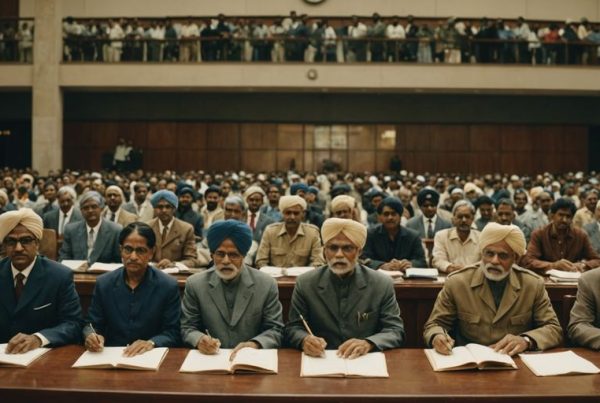The Bengal Partition of 1905 was a significant event in India’s history, orchestrated by the British colonial government. This division aimed to make governance easier but had far-reaching effects on the social, political, and economic landscape of Bengal. The partition created a divide between Hindus and Muslims, leading to communal tensions that would echo throughout India’s struggle for independence. In this article, we will explore the causes and consequences of this pivotal moment in history.
Key Takeaways
- The British aimed to simplify administration by dividing Bengal, which was too large to govern effectively.
- The partition intensified communal tensions between Hindus and Muslims, shaping future political dynamics.
- It sparked the Swadeshi Movement, where Indians boycotted British goods in protest against colonial rule.
- The partition was reversed in 1911 due to widespread protests and nationalistic sentiments.
- This event laid the groundwork for future divisions in India, influencing the eventual partition in 1947.
Historical Context of the Bengal Partition
British Colonial Rule in India
The British colonial rule in India began in the 18th century and expanded rapidly. By the early 1900s, the British had established control over a vast territory, including Bengal, which was one of the most populous regions. The British aimed to maintain control over the diverse population by implementing policies that often favored division over unity.
Socio-Political Landscape of Bengal
Bengal was a melting pot of cultures, languages, and religions. The population was predominantly Hindu in the west and Muslim in the east. This demographic split was significant, as it laid the groundwork for the political tensions that would arise from the partition. The region was also a hub for nationalist movements, which the British sought to suppress.
Economic Conditions in Bengal
Economically, Bengal was rich in resources and had a thriving trade network. However, the British policies often exploited these resources for their benefit, leading to economic disparities. The partition was partly justified by the British as a means to improve administrative efficiency, but it was also a strategy to weaken the growing nationalist sentiments.
| Aspect | Details |
|---|---|
| Population | Approximately 78 million |
| Major Religions | Hindu (West), Muslim (East) |
| Economic Activities | Agriculture, trade, and industry |
| Political Movements | Rise of Indian nationalism |
The partition of Bengal in 1905 was a pivotal moment in Indian history, marking the beginning of significant political unrest and mobilization against British rule.
Overall, the historical context of the Bengal Partition reveals a complex interplay of colonial strategies, socio-political dynamics, and economic conditions that ultimately led to one of the most controversial decisions in British India.
Administrative Reasons Behind the Partition
Challenges in Governing Bengal
Bengal was the largest province in British India, covering about 189,000 square miles and home to around 80 million people. Managing such a vast area was extremely difficult for a single lieutenant governor. The size made it hard for any governor to effectively oversee the entire province, leading to significant administrative challenges.
Role of Lord Curzon
Lord Curzon, the Viceroy of India, proposed the partition in 1905. He believed that splitting Bengal into two provinces would make governance easier. This decision was framed as a way to improve administration, but it also had underlying political motives. Curzon aimed to weaken the rising tide of nationalism in Bengal, which was seen as a threat to British rule.
British Strategic Interests
The British government had strategic interests in the region. By dividing Bengal, they hoped to reduce the influence of the educated middle class, particularly the Bengali intelligentsia, who were becoming increasingly vocal against colonial rule. The partition was also seen as a way to manage the growing nationalist sentiments among the people.
The partition was officially justified as an administrative necessity, but it had deeper socio-political implications that would resonate for decades.
In summary, the partition of Bengal was driven by administrative challenges, the strategic interests of the British, and the desire to control rising nationalism. This decision would lead to significant consequences for the region and its people.
Religious and Cultural Factors
Hindu-Muslim Demographics
The partition of Bengal in 1905 had a significant impact on the demographics of the region. The population was primarily composed of Hindus and Muslims, with each group having distinct cultural practices and social structures. The partition deepened religious and political divides, which contributed to the formation of the Muslim League in 1906. This division was not just administrative but also cultural, leading to a sense of rivalry between the two communities.
Cultural Differences
Cultural differences between Hindus and Muslims were pronounced in Bengal. These differences included:
- Religious Practices: Hindus and Muslims followed different rituals and festivals, which sometimes led to misunderstandings.
- Language and Literature: The two communities had their own languages and literary traditions, which further separated their cultural identities.
- Social Customs: Different social customs and traditions created barriers to interaction between the communities.
Impact on Social Harmony
The partition had a lasting effect on social harmony in Bengal. The growing tensions led to:
- Increased communal violence and riots.
- A decline in inter-community marriages and friendships.
- The rise of communal organizations that promoted division rather than unity.
The partition of Bengal was a pivotal moment that reshaped the social fabric of the region, leading to long-term consequences for Hindu-Muslim relations.
Economic Implications of the Partition
Trade and Commerce in Bengal
The partition of Bengal in 1905 had significant effects on trade and commerce. The division disrupted established trade routes and created confusion among merchants. The new boundaries meant that many businesses had to adapt to new regulations and market conditions.
Impact on Local Industries
Local industries faced challenges due to the partition. Many Hindu-owned businesses in West Bengal feared losing their market share to the newly formed East Bengal, which had a Muslim majority. This led to a decline in production and economic activity in some sectors.
British Economic Policies
The British government implemented policies that favored certain regions over others. This created economic disparities between East and West Bengal. The British aimed to exploit the resources of East Bengal while neglecting the needs of local industries.
| Aspect | Before Partition | After Partition |
|---|---|---|
| Trade Volume | High | Decreased |
| Local Industry Growth | Steady | Declined |
| British Investment | Balanced | Uneven |
The partition was not just a political move; it had deep economic consequences that affected the livelihoods of many.
Overall, the economic implications of the partition were profound, leading to unrest and dissatisfaction among the people of Bengal. The changes in trade, industry, and British policies created a complex economic landscape that would have lasting effects on the region.
Political Reactions to the Partition
The 1905 Partition of Bengal led to significant political reactions across the region. Many Indians viewed this partition as an attempt by the British to weaken the growing nationalist sentiments in Bengal. The response was marked by widespread protests and the rise of movements aimed at uniting the people against British rule.
Rise of Indian Nationalism
The partition ignited a strong wave of nationalism among Indians, particularly among the Hindus of Bengal. Key reactions included:
- Mass Meetings: Leaders organized large gatherings to discuss the implications of the partition.
- Petitions: Numerous petitions were sent to the British authorities demanding the annulment of the partition.
- Boycotts: The Swadeshi Movement emerged, encouraging people to boycott British goods and promote local products.
Swadeshi Movement
The Swadeshi Movement was a direct response to the partition, aiming to:
- Foster national unity among Indians.
- Promote local industries and goods.
- Challenge British economic policies.
Role of Indian National Congress
The Indian National Congress, under leaders like Gopal Krishna Gokhale, played a crucial role in opposing the partition. They:
- Resolved to support the Swadeshi Movement.
- Organized protests and rallies to raise awareness about the negative impacts of the partition.
- Worked to unite Hindus and Muslims against British policies.
The partition was seen as a deliberate attempt to create divisions among communities, which only fueled the fire of nationalism.
Summary of Reactions
The political reactions to the partition were characterized by:
- Unity among Hindus: Many Hindus viewed the partition as a threat to their cultural and economic dominance.
- Support from Muslims: Some Bengali Muslims initially supported the partition, believing it would enhance their political power.
- Long-term Consequences: The partition ultimately deepened communal divides, leading to future conflicts.
In conclusion, the political reactions to the Bengal Partition of 1905 were pivotal in shaping the course of Indian nationalism and resistance against British colonial rule. The events set the stage for future movements that would eventually lead to India’s independence.
Social Impact of the Partition
Public Sentiment and Protests
The partition of Bengal in 1905 stirred strong feelings among the people. Many viewed it as an insult to their homeland. This led to widespread protests across Bengal. On the day of the partition, October 16, 1905, people mourned and expressed their discontent. They tied rakhis to symbolize unity between Hindus and Muslims, showcasing their desire for harmony despite the division.
Role of Key Figures
Several prominent figures played crucial roles in opposing the partition. Rabindranath Tagore, a famous poet, composed the song ‘Amar Sonar Bangla,’ which later became the national anthem of Bangladesh. Leaders from the Indian National Congress, like Surendranath Banerjee, organized campaigns against the partition, emphasizing the need for unity among Indians.
Cultural Expressions of Resistance
The partition sparked various cultural responses. People engaged in the Swadeshi Movement, boycotting British goods to promote local industries. This movement not only united people against colonial rule but also fostered a sense of national identity. The protests and cultural expressions during this time laid the groundwork for future movements against British rule.
| Key Events | Date | Description |
|---|---|---|
| Day of Mourning | October 16, 1905 | People mourned the partition across Bengal. |
| Tagore’s Song | 1905 | ‘Amar Sonar Bangla’ was composed as a protest. |
| Swadeshi Movement Launch | 1905 | Boycott of British goods to support local industries. |
The partition of Bengal was not just a political move; it was a significant event that shaped the social fabric of India, leading to a rise in nationalism and unity among diverse communities.
Consequences of the Partition on Hindu-Muslim Relations
Long-term Communal Tensions
The partition of Bengal in 1905 created significant communal tensions between Hindus and Muslims. This division deepened the divide between the two communities, leading to a sense of mistrust and animosity that persisted for decades. The annulment of the partition in 1911 did not resolve these tensions; instead, it intensified feelings of separation among Bengali Muslims, who began to see themselves as a distinct group.
Formation of the Muslim League
In response to the growing discontent, the Muslim League was formed in 1906. This political organization aimed to represent Muslim interests in India. The Muslim League became a crucial platform for articulating the demands of Muslims, especially in the context of rising Hindu nationalism. It played a significant role in the political landscape leading up to the eventual partition of India in 1947.
Impact on Future Political Landscape
The consequences of the Bengal Partition had lasting effects on the political dynamics in India. The growing sense of Muslim identity and the formation of political organizations like the Muslim League laid the groundwork for future demands for autonomy and ultimately, the creation of Pakistan. The partition not only influenced the political strategies of the time but also shaped the communal relations that would define the subcontinent for years to come.
The partition of Bengal was a pivotal moment that altered the course of Hindu-Muslim relations in India, leading to a legacy of division that would echo through history.
Overall, the partition of Bengal was not just an administrative decision; it was a catalyst for significant changes in Hindu-Muslim relations, setting the stage for future conflicts and political movements.
Annulment of the Partition in 1911
Reasons for Reversal
The annulment of the partition of Bengal in 1911 was influenced by several key factors:
- Strong Hindu Opposition: The British underestimated the intensity of the Hindu backlash against the partition. With the departure of Lord Curzon, who had supported the partition, the plan lost its main advocate.
- Economic Losses: The Swadeshi movement, which encouraged boycotting British goods, led to significant economic losses for British businesses. This prompted them to lobby for the annulment of the partition.
- Visit of King George V: The upcoming visit of King George V to India created a need for unity among communities. The Indian National Congress demanded the annulment as a condition for their cooperation during the Delhi Darbar.
Impact on British Policies
The decision to annul the partition had a profound impact on British policies in India. It marked a shift in their approach, as they recognized the need to address the concerns of both Hindus and Muslims to maintain stability in the region.
Reactions from Indian Society
The annulment was met with mixed reactions:
- Many Hindus celebrated the decision, viewing it as a victory against British divide-and-rule tactics.
- Conversely, many Bengali Muslims felt betrayed, believing that the annulment favored Hindu interests over their own.
The annulment of the partition did not resolve the underlying tensions between Hindus and Muslims, which would continue to shape the political landscape of India in the years to come.
In conclusion, the annulment of the partition of Bengal in 1911 was a significant event that reflected the complexities of British colonial rule in India. It highlighted the challenges of managing diverse communities and set the stage for future political developments in the subcontinent.
Legacy of the Bengal Partition
The Bengal Partition of 1905 had lasting effects on Indian society and politics. Although the partition was reversed in 1911, its impact continued to shape Hindu-Muslim relations and the Indian independence movement.
Influence on Indian Independence Movement
- The partition ignited a wave of nationalism among Indians, leading to the rise of various movements aimed at opposing British rule.
- It united people across different communities against the British strategy of divide and rule.
- The Swadeshi Movement emerged as a direct response, promoting the use of Indian goods and boycotting British products.
Lessons Learned
- The partition highlighted the dangers of communal divisions, which would later resurface during the 1947 partition of India.
- It taught Indian leaders the importance of unity among different religious and cultural groups.
- The events surrounding the partition emphasized the need for a cohesive national identity.
Historical Significance
- The partition is often seen as a turning point in the struggle for independence, marking the beginning of organized resistance against colonial rule.
- It laid the groundwork for future political movements and the eventual formation of the Indian National Congress as a major political force.
The Bengal Partition of 1905 serves as a reminder of the complexities of communal relations in India and the importance of unity in the face of division.
In summary, the legacy of the Bengal Partition is profound, influencing not only the political landscape of India but also the social fabric that continues to evolve today. Its lessons remain relevant as India navigates its diverse and pluralistic society.
The Bengal Partition left a deep mark on history, shaping the lives of many. It’s important to understand its impact and learn from it. If you want to explore more about this topic and how it connects to today, visit our website for detailed insights and resources. Join us in uncovering the past!
Conclusion
In summary, the Partition of Bengal in 1905 was a significant event in India’s history. It was mainly driven by the British desire to manage a large province more effectively, but it also had deep social and political effects. The division created a divide between Hindus and Muslims, which led to increased tensions and protests. Many people in Bengal felt that this split was an insult to their homeland and united against it. Although the partition was reversed in 1911, its impact lingered on, influencing future events in India, including the eventual partition in 1947. This historical moment reminds us of the importance of unity and the dangers of division.
Frequently Asked Questions
What was the main reason for the Partition of Bengal in 1905?
The main reason for the Partition of Bengal was to make it easier for the British to govern the large province, which had a huge population and was difficult to manage effectively.
Who was the Viceroy responsible for the Partition of Bengal?
Lord Curzon was the Viceroy of India who announced and implemented the Partition of Bengal.
What were the two new provinces created after the Partition of Bengal?
The Partition created two provinces: East Bengal and Assam, and West Bengal.
How did the Partition of Bengal affect Hindu-Muslim relations?
The Partition intensified tensions between Hindus and Muslims, as it divided the population along religious lines, leading to long-term communal conflicts.
What was the reaction of the Indian National Congress to the Partition?
The Indian National Congress opposed the Partition, viewing it as a strategy by the British to weaken the nationalist movement.
What was the Swadeshi Movement?
The Swadeshi Movement was a response to the Partition, encouraging Indians to boycott British goods and promote local products.
When was the Partition of Bengal annulled?
The Partition of Bengal was annulled in 1911 after widespread protests and opposition from various groups.
What is the legacy of the Partition of Bengal?
The legacy of the Partition includes a lasting impact on Hindu-Muslim relations in India and played a significant role in the rise of Indian nationalism.





